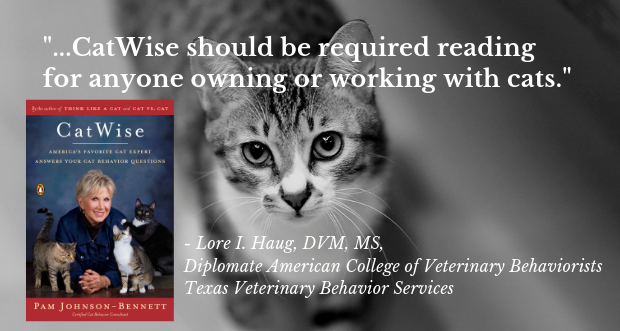
Listen to the audio version of this article
You’re probably very familiar with the fact that dogs can suffer from separation anxiety but you may not have realized cats can go through this as well. Many people have an inaccurate image of cats being solitary creatures who don’t need companionship but they actually are social and do form very strong bonds to their human family members and animal companions.
Causes of Separation Anxiety in Cats
Cats who were orphaned may be more prone to separation anxiety. Too-early weaning may also be a factor. It’s my opinion that how you’ve set up your cat’s environment plays a role as well. If your cat has no other activities and ways to build confidence without being attached to you at the hip, then that increases the chance of separation anxiety. I believe many cat parents also reinforce the separation anxiety by rewarding the cat for clingy, needy behavior.
Your cat may go along just fine and have no problem with you coming and going on a daily basis but then something, such as a change in work schedule, a vacation, a divorce, etc, could trigger separation anxiety.
Signs of Separation Anxiety in Cats
When the cat parent leaves, the cat may exhibit excessive meowing. Elimination outside of the litter box may also occur. The cat may urinate or defecate on the cat parent’s bed or on clothing belonging to that human family member. It’s easy to misread this behavior as one of spite but it’s really a way for kitty to self-soothe by mixing his scent with yours. It’s also a way that the cat attempts to help you “find” your way home. Think of it as the feline version of dropping bread crumbs along the path.
Other signs may include excessive self-grooming, eating too fast, or not eating at all when the cat parent isn’t present.
Treating Separation Anxiety in Your Cat
Before labeling your cat as having separation anxiety, it’s important he be examined by the veterinarian. The behavior being displayed may have an underlying medical cause. For example, elimination outside of the litter box may be due to a urinary tract issue or some other medical cause. Excessive grooming may be the result of external parasites, skin allergies, irritation, etc. Eating too fast or if your cat shows a lack of appetite, may also be caused by an underlying medical condition. Don’t skip this very important step of visiting your veterinarian.
Once your cat is diagnosed with separation anxiety, behavior techniques can be used to reduce stress and increase confidence when left home alone.
Increase the environmental enrichment. If you want your cat to feel satisfied, entertained, and secure when you aren’t around then the environment in which he lives has to inspire that. Read my article on environmental enrichment to learn how to spruce up his indoor surroundings. Incorporate puzzle feeders, playtime, elevated areas, hideaways and more to encourage him to find ways to trigger and satisfy his prey-drive. The more enriched and secure the environment is, the better your cat will feel when he’s by himself. If you know your cat is a real foodie and loves the puzzle feeders, then save them for when you won’t be home during the day. That way, they’ll become very special treats for your cat during your absence.
A cat tree is a great piece of real estate for a cat and it serves as a place to nap, play, climb, scratch, and if placed near a window will provide a front row seat to the birds outside. As long as there’s no threat of other cats coming into the yard, consider putting a bird feeder outdoors so your cat will have some first-rate entertainment while perched on his cat tree.
Inspire confidence when you interact with your cat. Don’t reward your cat with attention when he’s meowing and being insistent. Instead, reward him with petting, treats, praise, and attention when he’s acting the way you WANT him to act. Reward him when he’s quiet. Reward him when he does something to entertain himself. Reward the behavior you want to see again and don’t reinforce the unwanted behavior.
Engage your cat in interactive play sessions on a daily basis. Twice a day would actually be even better. Interactive playtime allows your cat to simply enjoy being the mighty hunter. For a cat, being able to engage the prey drive and enjoy a successful capture is the ultimate in joy and satisfaction.
Don’t make a big production about leaving. If you anticipate your cat is going to suffer from separation anxiety, you’ll just make it worse if you overdo the goodbye process. Your cat will think you’re leaving for a month instead of just 8 hours. Make your goodbyes very casual. Cats easily pick up on the emotions of their human family members. If you’re upset then your cat may get upset.
Practice coming and going. If your cat starts to get tense whenever he hears you pick up your keys or if he sees you reach for your purse or coat, then practice doing those things several times a day without actually leaving. Pick up your keys and put them back down. Do this multiple times. Later in the day, walk to the door and then back. Do that several times. Now, put the two together – pick up your keys, walk to the door and then back. Later in the day, put on your coat and then take it off and then add all three together – putting on your coat, getting your keys and walking to the door. Work up to actually walking out the door and then immediately returning. Each time you walk back into the room, greet your cat casually or engage in a little play session. Vary the times you do these training sessions throughout the day or evening. Gradually increase the time spent outside of the home.
If there are particular objects that trigger the anxiety such as your keys, your purse, your brief case – then carry those around the house for a while each day so they are no longer an anxiety trigger.
TV and Music
YouTube has countless videos that are cat-specific in terms of interest. Look for videos that showcase prey such as birds, mice or insects. You can have one playing when you’re set to walk out the door. For music, use a classical or soft music station. Just having soft music in the background may help serve as a buffer for any outside noises that might trigger kitty’s anxiety.
There are also cat-specific music downloads. This is special music designed to create a feeling of calm. Do an online search and you’ll find a couple of good options.
Pheromone help
Try using a Feliway plug-in diffuser. Although this by itself isn’t going to resolve separation anxiety, it may be a small piece of the puzzle that helps in combination with the behavior work you’re doing.
For added scent help, leave out a worn shirt or towel for your cat so he can surround himself with your comforting scent. Don’t do this if your cat has a tendency to urinate on articles of clothing though.
If Your Cat Needs Medication
There are some cases where anti-anxiety medication may also be needed in conjunction with behavior work. Your veterinarian or a veterinary behaviorist will advise the client based on the specifics of the cat’s case. If medication is prescribed, it MUST be used alongside appropriate behavior modification and is not to be viewed as a substitute for doing the behavior work needed to relieve the cat’s anxiety.
Consider a Feline Companion
Depending on the specifics of your situation, your cat may benefit from the addition of a kitty companion. If you decide to do this though, it’s crucial that you have the time to dedicate to a slow, positive introduction. Many cats enjoy the companionship of another cat but some simply do not so make this decision based on all you know about your own cat.
Need More Information?
If you’ve noticed a change in your cat’s behavior or you think he may be experiencing separation anxiety, contact your veterinarian so a thorough examination can be done. If your veterinarian does diagnose separation anxiety, you may be referred to a certified behavior professional.
For more information on easing a cat’s anxiety, refer to the best-selling books by Pam Johnson-Bennett. Pam’s books are available at bookstores and online. We’ve included links to Amazon here on our website.
If you have a question regarding your cat’s behavior or health, please contact your veterinarian. This article is not intended as a replacement for your cat’s veterinary care. This article is for information purposes only and not offering medical advice or providing a medical diagnosis.




